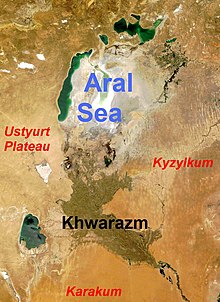Suyarganovo culture
 | |
| Geographical range | Aral Sea region |
|---|---|
| Period | Bronze Age |
| Dates | c. 2000 BC – 1000 BC |
| Preceded by | Kelteminar culture |
The Suyarganovo culture was an archaeological culture of the late Bronze Age, appearing at the beginning of the second millennium BC,[1] extending to around 1000 BC. The population of Suyarganovo culture, also known as Suyargan culture, lived in Aral, near Akcha Darya river (Amu Darya delta), the area of the historic Khwarezm. Stanislav Grigoriev (2016) suggests Suyarganovo culture began sometime around 2500-2000 BC.[2]
In the middle of the second millennium BC, the population of Suyarganovo culture coexisted with the tribes of the Tazabagyab culture. Typical ceramics - flat-bottomed vessels (often with a red or orange color) with a short neck (often with carvings) and rounded torso. Homes and dwellings of Suyarganovo occupies a large area, mostly along the banks of fluvial channels.
Stages
[edit]Post-Kelteminar
[edit]Main activity - hunting and fishing. Dwellings - columnar construction - ground, oval shape. The arrowheads, knives, scrapers from flint and quartzite. Flat-bottomed pottery modeled with a mixture of wood and seashells.[3]
Kamyshli
[edit]Main activity - irrigation farming. Kamyshli stage after migration a new population, historically associated with the south, to the territory of Turkmenistan (Anau archaeological culture)[4] and the Iranian plateau.[5]
Kaunda
[edit]Main activity - herding. Bronze sickles and edged knives. Pottery was burned and carefully covered with relief ornament. Characterized by large dwellings of 250×150 m (Kaunda-1). The instruments were made of stone and bronze. Dwellings - rectangular huts. Closely associated with the population Tazabagyab archaeological culture.
The ethnic origin
[edit]- Post-Kelteminar stage of Suyarganovo culture, some researchers have linked to the local Finno-Ugric component.[6][7]
- Kamyshli stage associated with the population of the migration Hurrians-Mitanni tribes[8] from Iranian plateau to the Aral Sea region in the II millennium b.c.[9]
- The latest - Kaunda stage of Suyurganovo culture is a consequence of cultural and ethnic contact the population of Suyarganovo culture with Indo-Iranian tribes (Tazabagyab culture).
The anthropological types
[edit]The basic anthropological type of population from Suyarganovo culture - Indo-dravidian, at a latest Kaunda stage with minor Eastern Mediterranean anthropological type characteristic of Andronovo tribes[10][11]
Archaeological dwellings
[edit]Kamyshli, Dzanbas-6 Kokcha-2, Bazar-2, Kaunda-1 and others.
Literature
[edit]- Гулямов Я. Г., История орошения Хорезма с древнейших времен до наших дней, Ташкент, 1957;
- Толстов С. П., Итина М. A., Проблема суярганской культуры//CA, 1960, № 1;
- Толстов С. П., По древним дельтам Окса и Яксарта, М., 1962.
See also
[edit]References
[edit]- ^ Kuzmina, Elena Efimovna, (2008). The Prehistory of the Silk Road, Victor H. Mair (ed.), University of Pennsylvania Press, Philadelphia, p. 78: "...This culture appeared in the first half of the second millennium B.C., developing out of the local Kelteminar Culture (Gulyamov et al. 1966)..."
- ^ Grigoriev, Stanislav, (2016). Metallurgical Production in Northern Eurasia in the Bronze Age, Archaeopress Publishing Ltd., p. 664: "...With intensification of aridization in the second half of the 3rd [millennium] BC considerable qualitative changes begun here. The Kelteminar culture is succeeded by a series of cultures of the Early Bronze Age. It is the Suyargan culture on the lower Amu-Darya River...formed on the basis of the late Kelteminar under an influence of the southern impulses from North-Eastern Iran..."
- ^ Культура и искусство древнего Хорезма. М., Наука, 1981, С.8.
- ^ Ртвеладзе Э.В. Цивилизации, культуры, государства Центральной Азии. Ташкент, УМЭД, 2005, С.11.
- ^ Начало этнической истории народов Средней Азии и Казахстана
- ^ Masson B.M. Древние цивилизации Востока и степные племена в свете данных археологии (in russian)
- ^ Yablonsky L.T. Kelteminar craniology. Intra-group analysis//Soviet Ethnography, Moscow, USSR Academy of Sciences, 1985, No 2. pp. 127-140
- ^ Muratov B.A., Suyunov R.R., Arsanov P.M. The DNA-genealogy of Bashkirs tribes - 5. The descendants of Muytens (Hurrians-Mitanni)//BEHPS, Volume 2, №10[1,2], November 2015, P.950-963
- ^ Толстова Л.С. Древнейшие юго-западные связи в этногенезе каракалпаков//Советская этнография, №2. М., 1971, С.29.
- ^ МХЭ. Вып. 5. М., I960; Гинзбург В.В., Трофимов Т.А. Палеоантропология Средней Азии. М., 1972, с. 81—88.
- ^ Атамуратова Д.Р. Этнокультурная ситуация в Хорезме (V-II тыс. до н.э.), С.22
